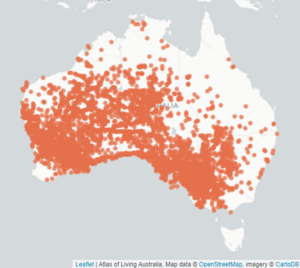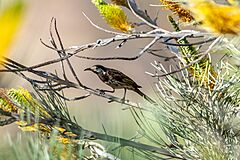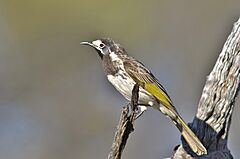White-fronted honeyeater facts for kids
Quick facts for kids White-fronted honeyeater |
|
|---|---|
 |
|
| Conservation status | |
| Scientific classification | |
 |
|
| Distribution of white-fronted honeyeaters throughout Australia. |
The white-fronted honeyeater (Purnella albifrons) is a medium-sized bird. It is only found in Australia. These birds mostly live in dry and partly dry areas.
White-fronted honeyeaters have special colors. They have a white face. Their upper chest is black or brown with white spots. Their brown wings have yellow patches.
The English bird artist John Gould first described this bird in 1841. He gave it the scientific name Glyciphila albifrons. The name albifrons means 'white forehead' or 'white front'. This comes from the Latin words albus (white) and frons (forehead).
The white-fronted honeyeater used to be in the Phylidonyris group of birds. Now, it has its own group, called Purnella. This name honors Herbert A. Purnell, who studied bird eggs and collected them.
Contents
What White-fronted Honeyeaters Eat
White-fronted honeyeaters mostly eat nectar from flowers. This is why they are called "honeyeaters." Scientists have studied their diet more closely. They found that when there isn't much nectar, these birds eat other things.
They might eat seeds, parts of plants, or insects. Being able to eat different foods helps them live in many places. It also helps them survive in dry areas. Scientists learned about their diet by watching them. They also looked at what was inside the birds' stomachs.
How They Live and Act
White-fronted honeyeaters move quickly. They fly around looking for food. They also try to avoid animals that might hunt them. These birds often visit tall shrubs. They like Eremophila shrubs and flowering mallee plants.
White-fronted honeyeaters build their nests in small groups. Living close to each other helps them. They can warn their neighbors if a predator is near. This is very important when they are raising their young.
The female honeyeater builds the nest. She uses things she can easily find. These include grasses, spider webs, roots, and plant stems. She weaves them together to make a cup-shaped nest. Then, she adds a soft lining inside. This lining is made of wool, cotton, fur, and plant material. It keeps the baby chicks warm and cozy. Nests are usually built on the lower branches of shrubs.
The female bird sits on the eggs to keep them warm and safe. When the eggs hatch, both parents work hard. They both find enough food for their young chicks.
Dangers for Honeyeaters
White-fronted honeyeaters must always be careful of predators. This is true even when they are caring for their young. Other birds can be a big danger to nesting honeyeaters. Birds like butcherbirds, currawongs, and corvids are known to raid nests. They might eat the eggs or young chicks of honeyeaters in Australia.
Some snakes are also known to eat eggs and chicks. For example, the northern brown snake can be a nest predator.
Sometimes, accidents happen during the breeding season. Heavy rain can destroy nests. It can also knock a nest out of a shrub. Even some honeyeater species have been known to accidentally damage eggs.
Protecting White-fronted Honeyeaters
The white-fronted honeyeater is currently listed as 'least concern' by the IUCN Red List. This means they are not in danger of disappearing. The bird population is safe in most parts of Australia. This includes SA, VIC, NSW, QLD, NT, and WA.
You won't find white-fronted honeyeaters in Tasmania. This is because it's too far from mainland Australia. Also, the land in Tasmania is different from where they usually live.
Gallery
-
The ability for white-fronted honeyeaters to blend in with their surroundings via camouflage.





